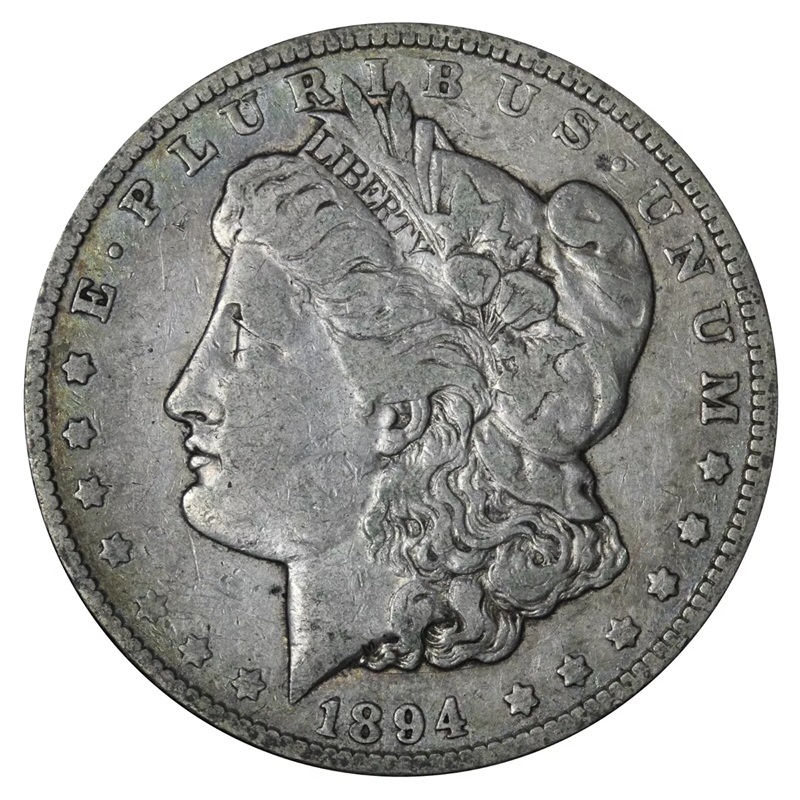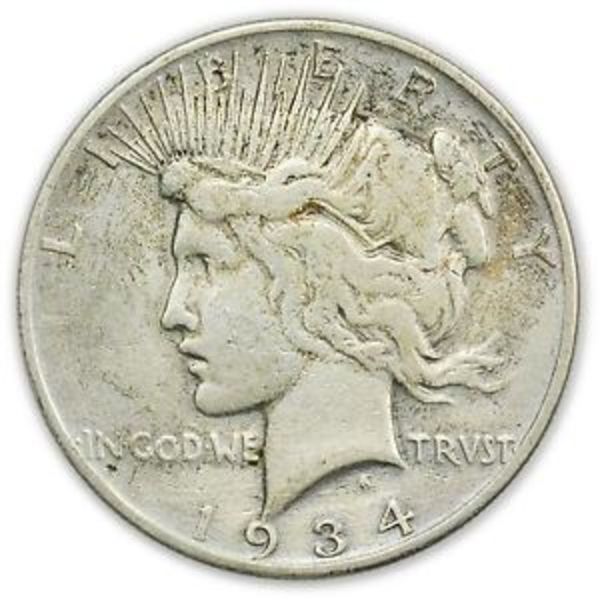1971-1976 Eisenhower Silver Dollar Melt Value
Determining the current price of silver coins is a straightforward process once you know the silver content of the coin and the current market price, often referred to as the silver spot price.
US Mint Silver Coin Melt Values
| Description | Face Value | ASW | Melt Value | Per $1 Face | Per Bankroll | |
|---|---|---|---|---|---|---|
| 40% Eisenhower Dollar | 1971-1976 Eisenhower Silver Dollar | $1.00 | 0.3161 | $25.27 | $25.27 | $252.66 |
1971-1976 Eisenhower $1 Coin
The 1971-1976 Eisenhower Dollar (commonly referred to as the "Ike Dollar") is a U.S. coin issued commemorating Dwight D. Eisenhower, the 34th President of the United States.
It was the last large-size dollar coin struck for circulation by the U.S. Mint. The reverse design, showing an eagle landing on the moon, also honors the Apollo 11 Moon Landing.
Eisenhower Dollar Variants
- Clad Eisenhower Dollars (1971-1978): Made from copper-nickel for general circulation.
- 40% Silver Eisenhower Dollars (1971-1974, 1976): Special collectors' issues made of 40% silver struck at the San Francisco Mint.
Composition
- Circulation Coins (Clad): 75% copper, 25% nickel bonded to a pure copper core.
- Collector Coins (40% Silver): 40% silver, 60% copper (only certain coins issued for collectors contained silver).
Mint Marks
- Philadelphia (no mint mark)
- Denver ("D")
- San Francisco ("S"): The San Francisco Mint produced 40% silver collector coins and proof versions of these coins.
- Special Editions and Proof Coins:
- 40% Silver Issues: From 1971-1974, and for the Bicentennial coins in 1976, the U.S. Mint struck 40% silver Eisenhower Dollars for collectors. These were not released for circulation and were sold directly by the Mint in special packaging.
- Proof Coins: Proof versions of the Eisenhower Dollar were also produced, mainly from the San Francisco Mint. The 40% silver-proof coins are particularly desirable, as they were struck in limited numbers for collectors.
- Bicentennial (1976): For the bicentennial celebration, a special reverse design featuring the Liberty Bell superimposed on the Moon was used on the 1975-1976 Eisenhower Dollars. These were issued with the dual date 1776-1976 and struck in clad and 40% silver versions. Proof and uncirculated versions were available, with the silver issues primarily aimed at collectors.
1971-1976 Eisenhower Dollar Values
For collectors and investors, the value of Eisenhower Dollars can be broken down into two categories: circulation (clad) coins and collector (40% silver) coins.
Most clad Eisenhower Dollars (1971-1978) in circulated condition hold little premium above their face value unless in high mint-state grades:
- Circulated (G to XF): $1.00 to $1.50 (close to face value)
- Uncirculated (MS60-MS63): $2.00 to $10.00
- Brilliant Uncirculated (MS64-MS66): $15.00 to $30.00 for common dates
- Proof Clad Coins (1971-1978): $5.00 to $15.00, depending on the year and condition.
The 40% silver Eisenhower Dollars are more valuable due to their silver content and limited issuance. To calculate the value of 40% silver Eisenhower Dollars, use the following formula:
For example, if silver is priced at $25 per troy ounce:0.3161 × $25 = $7.90 (intrinsic silver value).
Keep in mind that collector demand and condition can drive prices higher than just the silver value.
- Uncirculated (40% Silver, MS60-MS63): $10.00 to $20.00
- Proof Silver Coins (1971-1974, 1976): $15.00 to $30.00, depending on the year and condition
- Bicentennial Silver Coins (1976): $12.00 to $20.00 for uncirculated, higher for proofs
Key Dates and More Valuable Coins
While most Eisenhower Dollars in circulated condition are not particularly rare, there are a few notable coins:
- 1973-S Proof (40% Silver): One of the more sought-after coins due to its limited mintage for collectors.
- 1972 Type 2 Reverse: The 1972 Eisenhower Dollar has three varieties based on the reverse design (Type 1, 2, and 3). The Type 2 reverse, which features a more detailed image of the Earth, is scarcer and can command higher prices, especially in high grades.
- 1971-S Silver Dollar (Proof 70 Deep Cameo): Sold for $9,400 in 2019.
- 1976-S Bicentennial Silver Dollar (Proof 70): Sold for $8,000 in 2021.
- Weight (Clad): 22.68 grams
- Weight (Silver): 24.59 grams
- Diameter: 38.1 mm (1.5 inches)
- Silver Content (40% Silver Coins): 0.3161 troy ounces of pure silver
- Edge: Reeded
- A standard bankroll of Eisenhower Dollars contains 20 coins, which is equivalent to a $20 face value.
- Silver Content: The 40% silver coins provide intrinsic value, but the silver content is relatively low compared to other coins like Morgan or Peace Dollars, which contain 90% silver.
- Collector Demand: High-grade Eisenhower Dollars and specific key dates (such as the 1972 Type 2 and 1973-S silver proofs) have strong collector demand and can appreciate over time.
- Long-term Hold: While common-clad Eisenhower Dollars are unlikely to see significant value increases, high-grade proofs or rare varieties can be worth holding as part of a diversified numismatic collection.
- Type: Uncirculated Eisenhower Dollar (40% silver)
- Packaging: The coin is sealed in a clear plastic holder inside a blue envelope, giving it the nickname "Blue Ike."
- Years Issued: 1971-1974
- Mint Mark: All Blue Ike Dollars were minted at the San Francisco Mint and bear the "S" mint mark.
- Finish: The Blue Ike is an uncirculated coin, meaning it was struck for collectors but not with the special proof finish. As is typical with uncirculated coins, the coin may have some minor marks or bagging.
- Silver Content: Contains 40% silver or 0.3161 troy ounces of pure silver.
- Type: Proof Eisenhower Dollar (40% silver)
- Packaging: The coin comes in a more elaborate brown wood-grain-textured box with a U.S. Mint seal, hence the nickname "Brown Ike."
- Years Issued: 1971-1974
- Mint Mark: Like the Blue Ike, all Brown Ike Dollars were minted at the San Francisco Mint and bear the "S" mint mark.
- Finish: The Brown Ike is a proof coin, meaning it has a high-quality finish with a mirror-like surface and frosted devices. Proof coins are struck multiple times for sharp detail and visually appealing appearance.
- Silver Content: Also contains 40% silver or 0.3161 troy ounces of pure silver.
Auction Records
Some high-grade Eisenhower Dollars, especially those with rare varieties, have achieved impressive auction results:
Coin Roll Hunting
Coin roll hunting for Eisenhower Dollars is possible, but it is increasingly rare. Most banks no longer carry Eisenhower Dollars, and many were removed from circulation by collectors or hoarded.
However, it's not impossible to find them in unsearched bankrolls. While most Eisenhower Dollars found in circulation are clad, a silver issue is occasionally found.
Coin Specifications:
Investment Potential
Eisenhower Silver Dollars (especially the 40% silver collector issues) can be a decent investment for collectors, but they are not typically considered an optimal investment for silver bullion buyers. Key factors to consider:
"Brown Ike" vs "Blue Ike"
"Blue Ike" and "Brown Ike" refer to two distinct types of collectible Eisenhower Silver Dollars minted from 1971 to 1974 by the U.S. Mint, which contain 40% silver. The names "Blue" and "Brown" come from the packaging color used for each coin, and both were intended for collectors rather than for circulation. Here's a breakdown of the differences:
Blue Ike Dollar:
Brown Ike Dollar:
Blue Ike comes in a blue envelope, while the Brown Ike is housed in a brown box.
Typically, Brown Ikes (Proof) are more valuable than Blue Ikes (Uncirculated) due to their higher-quality finish and appeal to collectors. As of today, Blue Ike Dollars are generally valued between $10 to $25 USD, while Brown Ike Proof Dollars typically range from $20 to $40 USD or more, depending on condition and market demand.
Both types are sought after by collectors, but Brown Ikes (proofs) generally carry a higher premium due to their superior quality and packaging.
The 1971-1976 Eisenhower Dollar series offers both collectible value and intrinsic bullion value for the silver versions. Key dates and rare varieties can be valuable for collectors, and proof coins are especially sought after.
While not the best choice for silver bullion investors due to the lower silver content, the Eisenhower Silver Dollar is a popular coin for numismatists and casual collectors alike.





.jpg)




